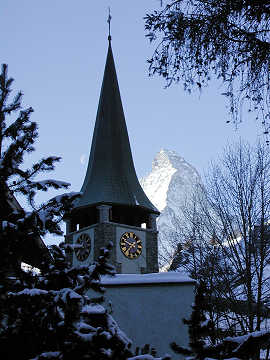 Morning
Early morning church bells echo in the Zermatt valley. Our ski boots
squeak and squelch in the snow as we walk up the little chalet-lined street
on the way to the base of Klein Matterhorn mountain (or Rothorn, or Gornergrat
depending on the direction). We turn left and walk past a frozen
outdoor ice rink. Forty or fifty curlers have congregated in the
early morning light, and we watch a man dressed in black pants, a red shirted
suspenders and pom-pom hat practice launching his curling stone -sliding
a bit more carefully yet gracefully across the ice and extending out his
body over the ice, arm reaching towards the other side of the pond -- as
he releases the stone. Two teammates, shuffling along and briskly
scrubbing the ice with brooms, race after the stone. There is something
intrinsically appealing to curling in view of the Matterhorn and the rest
of the Swiss Alps. Morning
Early morning church bells echo in the Zermatt valley. Our ski boots
squeak and squelch in the snow as we walk up the little chalet-lined street
on the way to the base of Klein Matterhorn mountain (or Rothorn, or Gornergrat
depending on the direction). We turn left and walk past a frozen
outdoor ice rink. Forty or fifty curlers have congregated in the
early morning light, and we watch a man dressed in black pants, a red shirted
suspenders and pom-pom hat practice launching his curling stone -sliding
a bit more carefully yet gracefully across the ice and extending out his
body over the ice, arm reaching towards the other side of the pond -- as
he releases the stone. Two teammates, shuffling along and briskly
scrubbing the ice with brooms, race after the stone. There is something
intrinsically appealing to curling in view of the Matterhorn and the rest
of the Swiss Alps.
We continue our walk up towards the mountains, breathing in the crisp
and surprisingly unpolluted mountain air and edging off the road to let
the small electric taxis pass us by. The town of Zermatt (at 1620
meters) bustles with skiers, snowboarders, children, tourists, and locals.
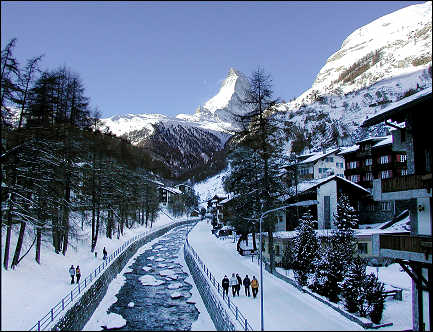 Our walk to the funicular (the underground high-speed cog train to Sunnegga, the mid-station point at 2288 meters) is with the other commuters on the way to the mountains. At the ticket booth, we purchase electronic cards (about $45 dollars with the current exchange rate), and drop them in an empty left handed pocket in our jackets before heading through the turnstiles to the train. Over the course of the week, we found that the electronic readers were much faster if there was nothing else in the pocket but the ski pass. Unlike North American lift tickets, there are no sticky tags or wickets. After walking through a series of tunnels, we approached the funicular, resting at a forty-five degree angle along a stairway, and began our morning "Swiss stairmaster" to quote a grumbling U.S. tourist beside me. By the time we settled into a rail car, we felt "warmed up" for the ski day, and we unzipped our jackets for the quick underground ride up the mountain.
Unlike the funicular, there is also a more scenic and slower cog train
from the middle of Zermatt to Gornergrat. The cog train is a great
way to see the Matterhorn, but it is not a fast ride. This train
makes a number of stops depending on if it is a local or express train.
(There are a few hotels along these stops, including the Riffelalp and
Gornergrat resorts. There is also a snow park for snowboarders and
a toboggan run. For those who want to try their hand at sledding,
there are rental places off of Riffelberg.
Skiing Zermatt is unlike most U.S. skiing we have done. We are used to popping up high speed quads and swooshing down one of four or six runs to return to the same high speed lift, and maybe switching lifts midway through the day. Zermatt has a much slower and scenic pace. For one thing, the lifts tend to be much longer than the ones in the U.S., so you don't just "pop" up and down the lift. The runs themselves have a different feel as well - most incorporate a few drops and steep parts, but also include a long and scenic traverse back to the lift or a restaurant. It's not uncommon to spend half your time traversing along a get-along trail or extended flat run. 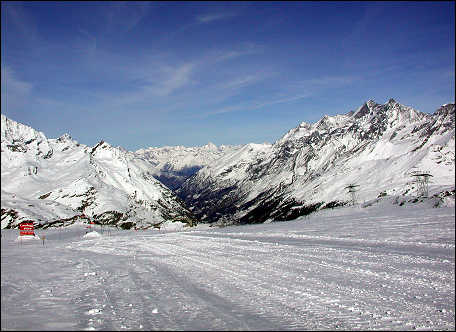 When the weather is nice, the mountain layout makes for some spectacular views. Because of the alpine elevation, you are surrounded by craggy mountain-tops, and of course, the Matterhorn, as you spend your day traversing and skiing. When the weather is foggy or snowy, this terrain makes for interesting skiing - without trees as landmarks, it is hard to get your bearings down the trails (an exception are the runs off the quad chair by Patrullarve). We noticed that most European skiers don't ski on cloudy or snowy days, and prefer instead to ski on warm sunny days.
The other thing we noticed here is that people preferred to ski the
groomed trails. While there are few trees to distinguish trails,
they are marked with long colored poles. If you like powder, you
can ski off the runs, but note that there are lots of unmarked obstacles,
and on the glacier, this could include deep cavernous and possibly treacherous
crevices. Corinne skied off the groomed stuff for a bit, but came
back in after cracking the front of her skis on a giant unmarked boulder.
Jeff, a better skier, said the trick was to follow in other people's tracks
(easy to see because there are few) so that you can anticipate problems.
We left the off-trail skiing to him.
We have heard that the best food in Zermatt is up the mountain, and we did not have a lunch up the mountain yet to disprove this belief. One day we ended up at Fluhalp, a larger looking restaurant off to the left of the main trails on the way down from Rothorn. From afar, it looks like a rustic two-story house dropped onto the side of the mountain. We traversed over a long flat run and gathered up speed to climb the small rise that the restaurant rested on. 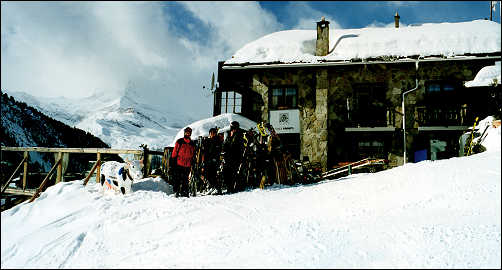 After parking our skis at the side of the restaurant, we walked through a dining porch area and into the restaurant. We passed all sorts of skiers and snowboarders gathered around steaming fondue pots and sipping glasses of red wine. In the restaurant, the server asked us if we had reservations (we did not), but since it was early (11:30 or so), he said he had room and took us upstairs to one of several small rooms with a medium sized table and seating for eight to ten. The room was empty when we arrived, and was very intimate and warm. We asked for an English menu and ordered several plates of rosti, a tomato cheese salad, and parma ham with melon. Like many other places in Zermatt, everyone spoke some English to us on sight. Our favorite spot for a casual lunch was at Tuftern. We ordered
our food at what looked like the front end of a rustic Swiss kitchen --
hot bowls of homemade minestrone soup with brown bread, dried sausage,
and cheese. Others ordered a thick apple tart with slices of apples
stacked upon themselves. On the first day, we sat outside on the
porch, taking in the surprisingly warm sun and the dramatic views of the
Matterhorn. On a colder day, we sat inside by the fire.
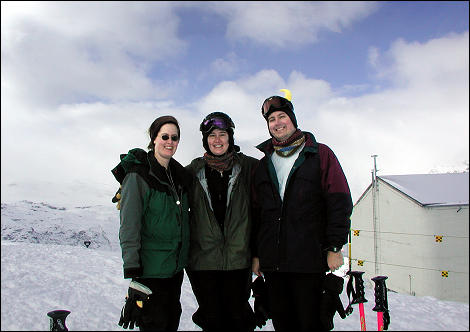 Another lunch stop is Findeln, a little village nestled near Sunnegga. Here you can eat at one of many restaurants. We ate at a little chalet crowded with lounge chairs and people enjoying good company and food. We enjoyed a variety of dishes, including curry vegetable soup, rosti with veal sausage, chocolate ice cream, and apple tarts. Just as easily, we could have had hot chocolate, beer, or wine. One of the really neat things about skiing Zermatt is that the Mountain straddles the Italian and Swiss border. On clear days, skiers can ski two countries in one day. You can get to Italy from Zermatt by taking chairlifts, or by tram via Klein Matterhorn. At the top of the tram, there is an ice cave and lookout point that you don't have to ski to (for those who just want to take in the views). The trails on the Italian side were wider than on the Swiss side, and were good "cruising runs" that softened as the day progressed. We skied into Cervinia and had lunch at a little Italian restaurant near the base of the gondola. Here we had pizzas, polenta, and espresso. The last tram up from the base of Cervinia to Switzerland is at 2:30. Skiers should keep a watch on the weather and the time unless you want to spend the night in Italy.  Zermatt is all about the experience, whether it be extraordinary food,
breathtaking views, friendly exchanges with the locals and other visitors,
or a great day skiing. We look forward to our next trip back to the
enchantment of the little village in the lap of the Matterhorn.
Corinne started skiing on our Rocky Mountain ski trips when she was 6 years old; Max grew up skiing in the Northeast. They have their own travel website at www.triptreks.com which includes several Caribbean resort and scuba diving reviews, and an adventure trip in Jackson Hole, Wyoming. |
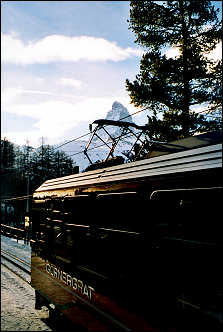 Most
lifts up the mountain are protected like the rail car - they are either
small four person gondolas or trams ranging from small (30 person) to large
(140 Person) cabins. There are a few chair lifts (more on Cervina,
the Italian side), and some shorter t-bars in places as well. Depending
on where you are staying in Zermatt, you might need to hike a bit, take
a taxi or bus to get to either the funicular to Sunnegga or the gondola
to Trockener Steg.
Most
lifts up the mountain are protected like the rail car - they are either
small four person gondolas or trams ranging from small (30 person) to large
(140 Person) cabins. There are a few chair lifts (more on Cervina,
the Italian side), and some shorter t-bars in places as well. Depending
on where you are staying in Zermatt, you might need to hike a bit, take
a taxi or bus to get to either the funicular to Sunnegga or the gondola
to Trockener Steg.
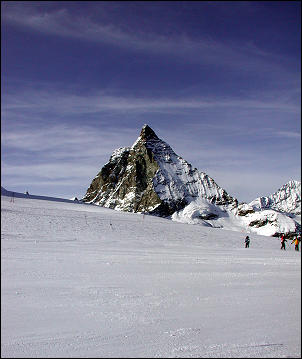 The
mountain terrain also influences the way people ski, and the types of skis
suggested for rentals. The preferred method of skiing in Zermatt
is giant slalom, straight down the mountain. The rental shop kept
renting Max and Dad "giant slalom skis" - monsters that like to point down
the mountain and go fast. If you like making carved turns, be sure
to ask for slalom or carving skis, and be aware that you will be a minority
on the mountain. Rest assured, we received top quality skis.
Snowboarders might need to be careful about where they go on the mountain,
as some of the traverses might be a little long for them to ride.
The
mountain terrain also influences the way people ski, and the types of skis
suggested for rentals. The preferred method of skiing in Zermatt
is giant slalom, straight down the mountain. The rental shop kept
renting Max and Dad "giant slalom skis" - monsters that like to point down
the mountain and go fast. If you like making carved turns, be sure
to ask for slalom or carving skis, and be aware that you will be a minority
on the mountain. Rest assured, we received top quality skis.
Snowboarders might need to be careful about where they go on the mountain,
as some of the traverses might be a little long for them to ride.
